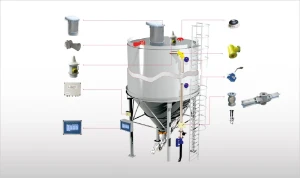Silo safety
Filling a silo means pumping/conveying powder (or bulk solids) and air into a closed container. Filling a silo is therefore somewhat similar to filling a balloon, but with one key difference: the silo isn't actually a balloon; it cannot stretch to accomodate more; it cannot contract to accomodate less content either. Therefore, filling or emptying a silo isn't as simple as one might think.
This is why there is a whole range of mechanisms and products by WAMGROUP that help to safeguard the integrity of the silo and therefore also of the people working in its vicinity.
- Level indicators to know the degree to which the silo is filled.
- Electronic pressure meters to monitor the pressure rising or falling in the silo during filling or purging.
- Safety valves to act as as a pressure equalizer with the environment and as a last measure against overpressure or underpressure.
- Electronic safety systems to tie everything together in an operator-friendly manner.
Pressure relief valves
Even though ideally a Pressure Relief Valve should never have to go into action, it must be efficient and reliable if needed.
VCP Pressure Relief Valves consist of a cylindrical casing with a bottom flange to be connected with a spigot welded on the silo roof, a disc shape inner steel lid for negative pressure operation held in position by a central spring rod, an outside steel ring for excess pressure kept in position by three spring rods, gaskets, and a weather protection cover.
Helical springs keep the valve lids closed when the pressure value remains within the preset limits. The three outside spring rods keep the external ring-shaped lid firmly closed as long as the force generated by the pressure inside the silo does not overcome the spring force. Once the pressure exceeds the pre-set value the lid is pushed up and pressure can escape. The smaller lid covers the central circular opening of the external lid from below. It is held in the middle by a single spring rod and is pressed onto the external lid by the normal air pressure inside the silo.
In the event of suction pressure the spring is compressed and allows the lid to drop. The air entering the silo from outside ensures rapid pressure balance and pushes the central lid back up into "closed" position.
For applications in the food industry a version compliant with European Regulation (EC) No. 1935/2004 is available.
Electronic pressure meters
IPE efficiently supervises the pressure rising inside bins or silos during filling and purging of tankers.
The IPE-type Electronic Pressure Meter consists of a self-cleaning wear and temperature-resistant membrane, a casing manufactured from aluminium alloy, an electronic card and assembly fittings (bolts and gasket).
By means of an electronic reading device which is activated by a membrane, the IPE-type Electronic Pressure Meter supervises the pressure rising inside bins or silos during filling and purging of the tanker.
Bin level indicators
Easy-to-install, versatile, cost-effective and reliable level indication for bins and hoppers.
ILT-type Bin Level Indicators are designed for electric signalling by rotary action of minimum or maximum material level inside bins, hoppers or silos.
As soon as the material level reaches the measuring paddle rotation is blocked. As soon as the material level sinks below the paddle radius, rotation restarts activating other system components. The top or side-mounted indicators are commonly used for powdery and granular materials.
Silo safety system
The KCS system prevents both overfilling and excess pressurisation avoiding damage to silo, venting filter and other accessories.
Damage to a silo or its accessories is most likely during filling operation from the tanker due to the risk of overfilling or excess pressurisation.
The KCS system prevents both overfilling and excess pressurisation avoiding damage to silo, venting filter and other accessories. It also reduces the risk of dust emission into the atmosphere.
The KCS Silo Safety System for the safeguarding of silos consists of a central electronic monitoring and control panel which manages a series of silos and a component kit including, in the basic version, one power panel for each silo, a silo pipe connection, a pinch valve, a tanker coupling to the filling pipe, a maximum level indicator, a differential pressure switch or electronic pressure meter, a pressure gauge for the venting filter, a pressure relief valve, and an audible alarm.
The KCS Silo Safety System can be used for silos which are filled with powders or granular materials by tanker. Damage to the silo or its accessories is most likely during filling operation from the tanker. This is due to the risk of overfilling or excess pressurisation.
The KCS system, supplied in component form, prevents both overfilling and excess pressurisation, thus avoiding damage to the silo, to the venting filter or other accessories, and reducing the risk of dust emission into the atmosphere.







